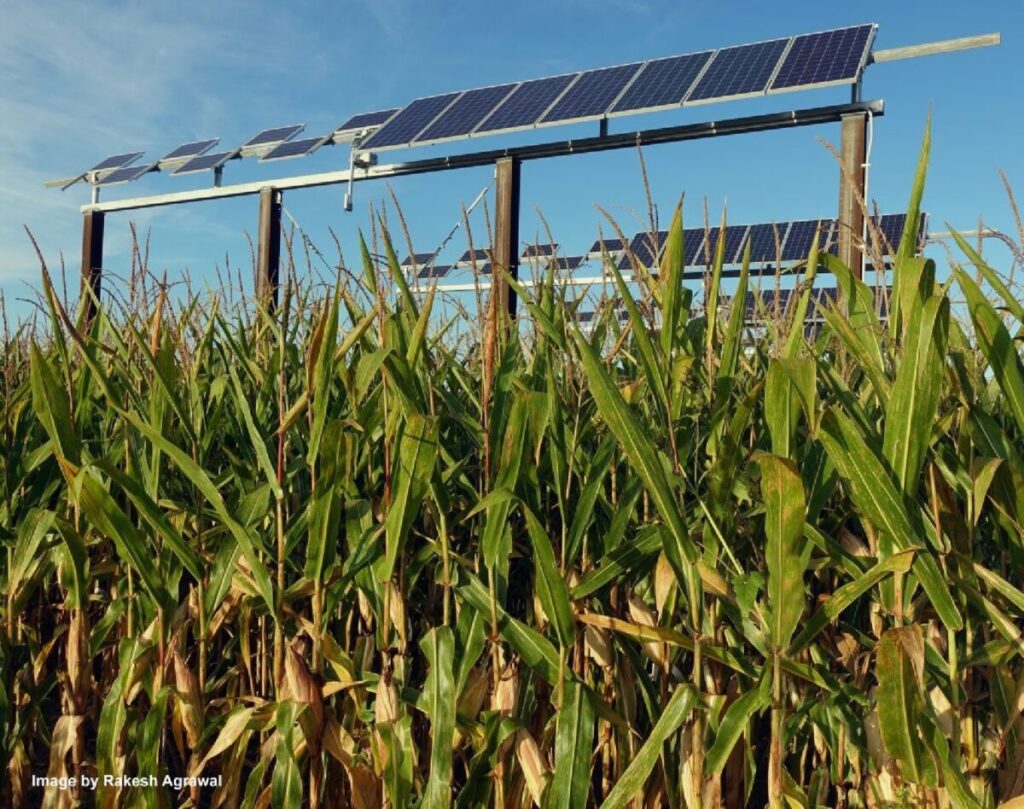Researchers from Purdue University have studied the impact of traditional photovoltaic systems and agrivoltaic systems deployed in corn farming areas. They conclude that agrivoltaic energy could provide a viable strategy to ease the current trade-off between energy production, greenhouse gas emissions, food production and farm profitability.
A team of researchers from Purdue University has found that agrivoltaic energy has the potential to increase energy production and reduce carbon emissions, while having minimal impact on crop production.
In the research paper “The viability of solar photovoltaics on agricultural land: can PV solve the food vs. fuel debate?”, available in the Magazine for cleaner productionthe team analyzed five scenarios involving corn farms in the Midwestern United States.
The first is the base case, where corn is grown over the entire area. The second includes a traditional solar system installed on 25% of the area, replacing the corn crop. The other three scenarios involve agrivoltaic systems that include corn, with an estimated 5.5% of land occupied by solar structures and unavailable for crop growth. The third system uses full solar panel density, followed by half and quarter panel density in the fourth and fifth systems.
The researchers compared these five systems on four measures: the production of corn for use as food or feed, the production of energy in the form of bioethanol or electricity, the reduction of greenhouse gas emissions and the profitability for the farmer.
The highest food/feed production was achieved in the basic system. In the second system, the amount of corn as food/feed decreased by 25%, in proportion to the reduction in available land. Yields from the agrivoltaic systems varied based on the shaded boundaries, with an 11% reduction in the amount of corn available for food/feed recorded in the quarter-solar panel density system compared to the baseline system.
Compared with the baseline system, the traditional photovoltaic system and the quarter-density agrivoltaic system increased end-use energy production from less than 2 MWh/ha/year to about 140 MWh MWh/ha/year. The half-density agrivoltaic system increased energy production to approximately 280 MWh/ha/year and the full-density agrivoltaic system increased energy production to approximately 560 MW/ha/year.
The researchers also found that ethanol has a minimal impact on total energy production in systems two through five. “Therefore, there was no significant difference in total energy yield when looking at the low and high shade yield limits of corn production,” the team said.
When calculating the greenhouse gas reductions, the basic system, with only ethanol as an energy source, had a reduction of less than 2 tons of CO2 eq/ha/year. The other systems reduced emissions by hundreds of tonnes of CO2eq/ha/year, with the amount in each system “trending similarly to the number of solar panels incorporated in the entire treatment area”.
While the traditional photovoltaic system and the quarter-density agrivoltaic system had essentially the same energy generation and greenhouse gas reductions, the research report predicts a higher corn yield for the agrivoltaic system because it allows for more crop growth and shade was minimized due to the large distance between fields. panels.
In the report’s conclusion, the researchers say that agrivoltaic energy “can provide a viable strategy to ease the current trade-off between energy production, greenhouse gas emissions, food production and farm profitability.”
“Our analysis indicates that both photovoltaic systems and agricultural voltaic systems can significantly increase energy production per hectare over the baseline, where approximately 27% of corn is attributed to ethanol,” the researchers noted.
The researchers also explain that while agrivoltaic energy deployment may be affected by high capital costs, this barrier can be overcome with policy support, especially when crop prices are highly volatile. They say associated costs should decrease as technology develops, but warn that more work needs to be done to ensure better understanding of stakeholder needs and improved engineering to reduce costs while improving maximize system output.
“Integrating solar photovoltaics into agricultural land offers greater potential for renewable energy production and reducing greenhouse gas emissions,” the paper says. “Our calculations show that in the absence of ethanol demand, the amount of corn available as a food and feed source can actually be increased, even if solar panels are integrated, compared to the amount available under demand conditions to ethanol and without photovoltaic integration. In this view, agrivoltaic technologies provide a viable solution to the food versus fuel debate, allowing large amounts of energy to be produced with minimal impact on corn as a food/feed source.”
Earlier this year, researchers at Purdue University created a new model for assessing corn growth in agricultural voltaics by proposing a spatiotemporal shade distribution model to optimize crop yield and energy production.
This content is copyrighted and may not be reused. If you would like to collaborate with us and reuse some of our content, please contact: editors@pv-magazine.com.

